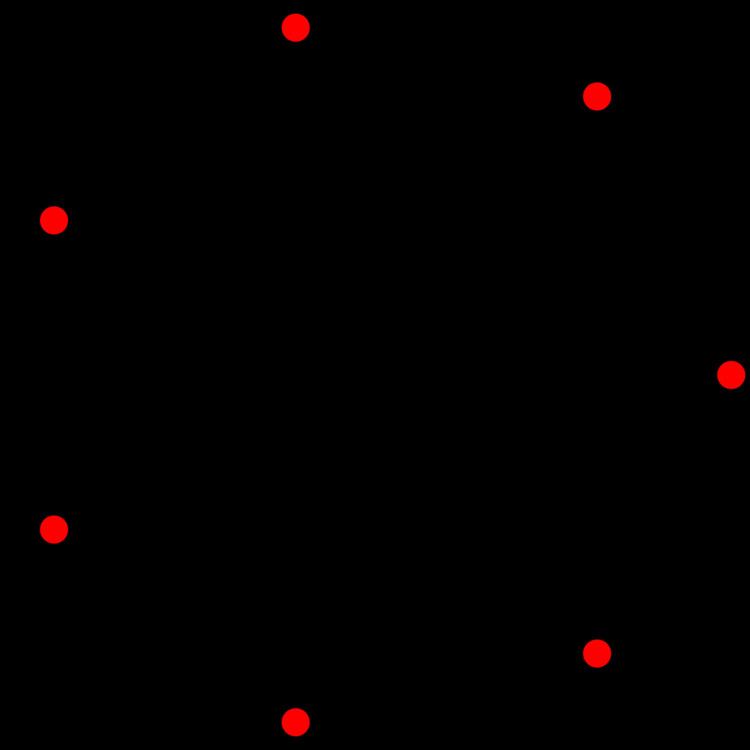 | ||
In six-dimensional geometry, a pentellated 6-simplex is a convex uniform 6-polytope with 5th order truncations of the regular 6-simplex.
Contents
- Alternate names
- Coordinates
- Root vectors
- Images
- Omnitruncated 6 simplex
- Permutohedron and related tessellation
- Related uniform 6 polytopes
- References
There are unique 10 degrees of pentellations of the 6-simplex with permutations of truncations, cantellations, runcinations, and sterications. The simple pentellated 6-simplex is also called an expanded 6-simplex, constructed by an expansion operation applied to the regular 6-simplex. The highest form, the pentisteriruncicantitruncated 6-simplex, is called an omnitruncated 6-simplex with all of the nodes ringed.
Alternate names
Coordinates
The vertices of the pentellated 6-simplex can be positioned in 7-space as permutations of (0,1,1,1,1,1,2). This construction is based on facets of the pentellated 7-orthoplex.
A second construction in 7-space, from the center of a rectified 7-orthoplex is given by coordinate permutations of:
(1,-1,0,0,0,0,0)Root vectors
Its 42 vertices represent the root vectors of the simple Lie group A6. It is the vertex figure of the 6-simplex honeycomb.
Images
Note: (*) Symmetry doubled for Ak graphs with even k due to symmetrically-ringed Coxeter-Dynkin diagram.Alternate names
Coordinates
The vertices of the runcitruncated 6-simplex can be most simply positioned in 7-space as permutations of (0,1,1,1,1,2,3). This construction is based on facets of the runcitruncated 7-orthoplex.
Alternate names
Coordinates
The vertices of the runcicantellated 6-simplex can be most simply positioned in 7-space as permutations of (0,1,1,1,1,2,3). This construction is based on facets of the penticantellated 7-orthoplex.
Alternate names
Coordinates
The vertices of the penticantitruncated 6-simplex can be most simply positioned in 7-space as permutations of (0,1,1,1,2,3,4). This construction is based on facets of the penticantitruncated 7-orthoplex.
Alternate names
Coordinates
The vertices of the pentiruncitruncated 6-simplex can be most simply positioned in 7-space as permutations of (0,1,1,1,2,3,4). This construction is based on facets of the pentiruncitruncated 7-orthoplex.
Alternate names
Coordinates
The vertices of the pentiruncicantellated 6-simplex can be most simply positioned in 7-space as permutations of (0,1,1,2,3,3,4). This construction is based on facets of the pentiruncicantellated 7-orthoplex.
Images
Note: (*) Symmetry doubled for Ak graphs with even k due to symmetrically-ringed Coxeter-Dynkin diagram.Alternate names
Coordinates
The vertices of the pentiruncicantitruncated 6-simplex can be most simply positioned in 7-space as permutations of (0,1,1,2,3,4,5). This construction is based on facets of the pentiruncicantitruncated 7-orthoplex.
Alternate names
Coordinates
The vertices of the pentisteritruncated 6-simplex can be most simply positioned in 7-space as permutations of (0,1,2,2,2,3,4). This construction is based on facets of the pentisteritruncated 7-orthoplex.
Images
Note: (*) Symmetry doubled for Ak graphs with even k due to symmetrically-ringed Coxeter-Dynkin diagram.Alternate names
Coordinates
The vertices of the pentistericantittruncated 6-simplex can be most simply positioned in 7-space as permutations of (0,1,2,2,3,4,5). This construction is based on facets of the pentistericantitruncated 7-orthoplex.
Omnitruncated 6-simplex
The omnitruncated 6-simplex has 5040 vertices, 15120 edges,16800 faces (4200 hexagons and 1260 squares), 8400 cells, 1806 4-faces, and 126 5-faces. With 5040 vertices, it is the largest of 35 uniform 6-polytopes generated from the regular 6-simplex.
Alternate names
Permutohedron and related tessellation
The omnitruncated 6-simplex is the permutohedron of order 7. The omnitruncated 6-simplex is a zonotope, the Minkowski sum of seven line segments parallel to the seven lines through the origin and the seven vertices of the 6-simplex.
Like all uniform omnitruncated n-simplices, the omnitruncated 6-simplex can tessellate space by itself, in this case 6-dimensional space with three facets around each hypercell. It has Coxeter-Dynkin diagram of .
Coordinates
The vertices of the omnitruncated 6-simplex can be most simply positioned in 7-space as permutations of (0,1,2,3,4,5,6). This construction is based on facets of the pentisteriruncicantitruncated 7-orthoplex, t0,1,2,3,4,5{35,4}, .
Images
Note: (*) Symmetry doubled for Ak graphs with even k due to symmetrically-ringed Coxeter-Dynkin diagram.Related uniform 6-polytopes
The pentellated 6-simplex is one of 35 uniform 6-polytopes based on the [3,3,3,3,3] Coxeter group, all shown here in A6 Coxeter plane orthographic projections.
